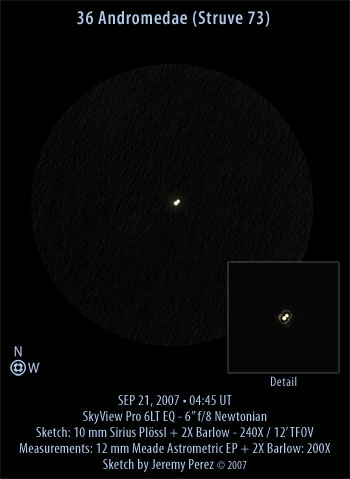
Click image for larger version
Observation Notes:
This double emitted a warm yellow light and was closely spaced. Seeing was not great, so I had some trouble estimating the separation of the two stars. There was clearly a black gap between the two, and the best I could tell, the first diffraction ring seemed to bisect its companion’s diffraction disc. That led me to estimate a separation of 1.2 arc seconds. PA measurements using my astrometric eyepiece on these close, jumpy doubles is pretty tough too. I came up with 315 degrees. Values noted in Brian Workman’s Double Star Calculator for 2007.7 are 320.4 degrees and 1.03 arc seconds.
| Subject | 36 Andromedae (STF 73) |
| Classification | Double Star |
| Position (J2000) | Andromeda [RA: 00:54:58.1 / Dec: +23:37:41]* |
| Position Angle* | 315° [my measurement] 320.4° [2007.7 B. Workman DS Calculator] |
| Separation* | 1.2″ [my measurement] 1.03″ [2007.7 B. Workman DS Calculator] |
| Magnitudes* | 6.1 / 6.7 |
| Spectral Types* | K1IV |
| Date/Time | SEP 20, 2007 – 09:45 PM MST (SEP 21, 2007 – 04:45 UT) |
| Observing Loc. | Flagstaff, AZ – Home |
| Instrument | Orion SVP 6LT Reflector (150 mm dia./1200 mm F/L) |
| Eyepieces/Mag. | 10 mm Sirius Plössl + 2X Barlow (240X) 12 Meade Astrometric EP + 2X Barlow (200X) |
| Conditions | Breezy, 1st quarter moon, patchy cirrus |
| Seeing | 5/10 Pickering |
| Transparency | NELM Mag ~5.0 |
| *References | The Washington Visual Double Star Catalog, 1996.0 (Worley+, 1996); Catalogue of Stellar Spectral Classifications (Skiff, 2005); Starry Night Pro Plus 5.8 |